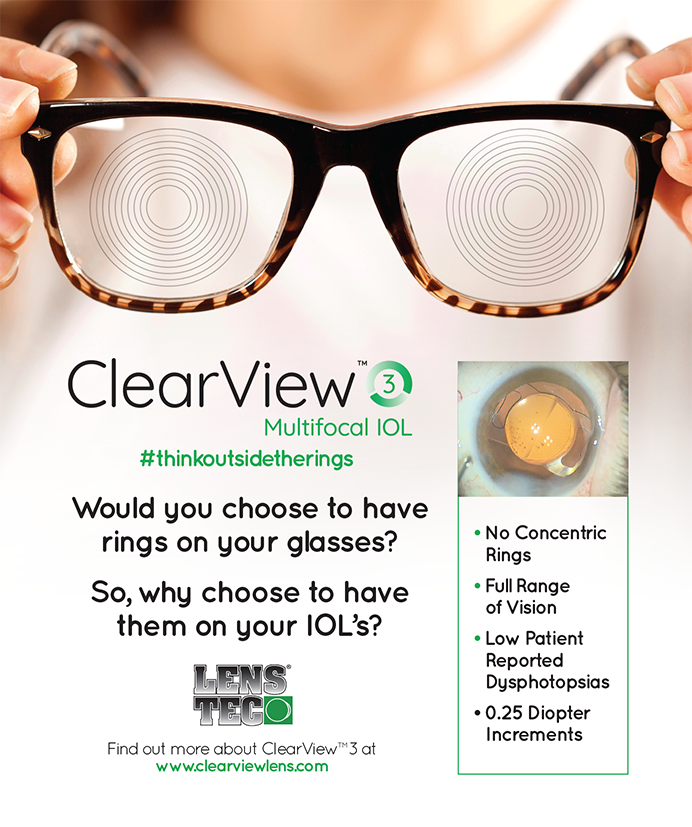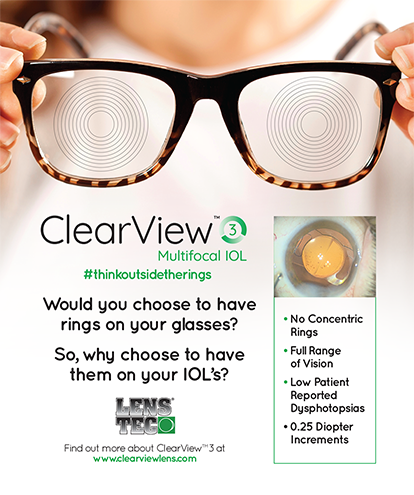Infectious keratitis is a rare but sight-threatening complication of LASIK. Its incidence has risen during the past decade, and trends in causative organisms 1 have shifted. The prompt diagnosis of the condition and the early initiation of treatment are crucial to obtaining the best possible outcomes. The prognosis varies widely and depends largely on the etiologic organism, but with appropriate treatment, good visual outcomes can be expected for the majority of patients.
EPIDEMIOLOGY/INCIDENCE
Because of the rarity of infectious keratitis, estimates of its incidence have varied significantly. In their comprehensive review of the literature, Chang et al found an incidence of between 0% and 1.5%. They stipulated, however, that many cases of infectious keratitis are not reported, so the actual rate may be higher.2 Further data were collected by the ASCRS Cornea Clinical Committee, which calculated the incidence to be between about 1/2,000 and 1/3,000 cases in earlier surveys and 1/1,100 in a more recent survey. In the more recent survey, however, the authors stated that the true incidence is likely much lower than that reported due to a low response rate and response bias.1,3,4
In a recent report, Llovet et al used the largest sample size from a single institution to estimate the incidence of infectious keratitis from this group as well as to gather other important clinical data such as causative organisms and prognosis.5 The investigators included data from 204,586 LASIK procedures performed in Clinica Baviera in Spain. They found the incidence of infectious keratitis to be 0.035% per procedure (or 1/2,857 cases), with about two-thirds of infections occurring within 7 days of the procedure. Risk factors for developing infectious keratitis included blepharitis, an intraoperative epithelial defect, and dry eye.
CAUSATIVE ORGANISMS OR TRENDS
During the past decade, there has been a shift in the most common organisms found to cause infectious keratitis after LASIK/PRK surgery. Based on data from the 2001 ASCRS survey, the microbe most frequently caus- ing the condition was atypical mycobacteria (33/116 cases), followed by culture-negative infectious keratitis (26/116) and staphylococci (23/116). In the 2008 ASCRS survey, the most common cause of infectious keratitis was methicillin resistant Staphylococcus aureus (MRSA), and no cases of atypical mycobacteria were reported.1 The study’s authors suggested the widespread use of fourth-generation fluoroquinolones as the likely reason behind the sharp decline in cases of atypical mycobacteria. These agents were not available at the time of the 2001 survey and have markedly increased in vitro activity against atypical mycobacteria compared with earlier fluoroquinolones.
In a study by Llovet et al, the microbes most frequently identified in post-LASIK infectious keratitis were gram-positive cocci (the most common was Staphylococcus epidermidis).5 The researchers reported a high rate of culture-negative infectious keratitis and no cases of MRSA-associated infectious keratitis. They speculated that the difference in rates of MRSA- associated infectious keratitis might be due to the higher carriage rate of MRSA in the United States compared with Europe.
TREATMENT
Cases of post-LASIK infectious keratitis can generally be divided into two groups: early onset (ie, within the first 2 weeks of surgery) and late onset (ie, after 2 weeks). Early-onset infectious keratitis is more likely to be caused by gram-positive cocci such as staphylococci and streptococci. Late-onset infectious keratitis is more likely to be caused by opportunistic microbes such as atypical mycobacteria, Nocardia, and fungi.
Regardless of the time of onset, upon suspecting infectious keratitis clinically, the surgeon should consider lifting the flap and then scraping and culturing the interface for guidance on antibiotic therapy. Culture media should be selected based on the time of onset (ie, for late-onset infectious keratitis, include atypical mycobacteria-sensitive media such as Lowenstein- Jensen or Middlebrook 7H-9 agar).
Initial treatment includes lifting the flap and irrigating the interface with appropriate antibiotics, again guided by the time of onset. The patient should then be started on frequent topical antibiotic therapy and observed closely. The choice of agents depends on the time of onset (ie, fortified vancomycin for early-onset and fortified amikacin for late-onset infections) (Figure 1).4
PROGNOSIS
The prognosis in cases of post-LASIK infectious keratitis can be favorable. Final BCVA has been shown to be 20/40 or better in up to 93% of patients.5 Residual corneal scarring is the primary cause of decreased vision.Furtherinterventionmayberequiredaspartof visual rehabilitation, including penetrating keratoplasty, arcuate keratotomy, phototherapeutic keratectomy, LASEK, a LASIK enhancement, and the treatment of haze with mitomycin C. Chang et al found that the time between the onset of symptoms and a flap-lifting procedure played an important role in patients’ recovery and prognosis. The investigators emphasized the need for prompt attention and treatment when infectious keratitis is suspected.2
CONCLUSION
Although the overall incidence of infectious keratitis appears to have declined during the past decade, there has been a shift from opportunistic agents to gram-positive cocci, including MRSA, as the causative organisms. Prompt evaluation and treatment should be initiated to ensure the best outcome, and the latter should include cultures.
Brian Alder, MD, is a resident at the Duke Eye Center in Durham, North Carolina. Dr. Alder may be reached at brian.alder@duke.edu.
Terry Kim, MD, is a professor of ophthalmology, cornea, and refractive surgery at the Duke Eye Center in Durham, North Carolina. Dr. Kim may be reached at (919) 681-3568; terry.kim@duke.edu.
- Solomon R,Donnenfeld ED,Holland EJ,et al.Infectious keratitis trends following refractive surgery:results of the 2008 ASCRS Infectious Keratitis Survey and comparisons to ASCRS Infectious Keratitis Surveys conducted in years 2001 and 2004.J Cataract Refract Surg.In press.
- ChangMA,JainS,AzarDT.Infectionsfollowinglaserinsitukeratomileusis:anintegrationofthepublishedlitera- ture.Surv Ophthalmol.2004;49(3):269-280.
- SolomonR,DonnenfeldED,AzarDT,etal.Infectiouskeratitisafterlaserinsitukeratomileusis:resultsofanASCRS survey.J Cataract Refract Surg.2003;29(10):2001-2006.
- DonnenfeldED,KimT,HollandEJ,etal.ASCRSwhitepaper:managementofinfectiouskeratitisfollowinglaserin situ keratomileusis.J Cataract Refract Surg.2005;31(10):2008-2011.
- LlovetF,deRojasV,InterlandiE,etal.Infectiouskeratitisin204586LASIKprocedures.Ophthalmology. 2010;117(2):232-238.e1-4.


